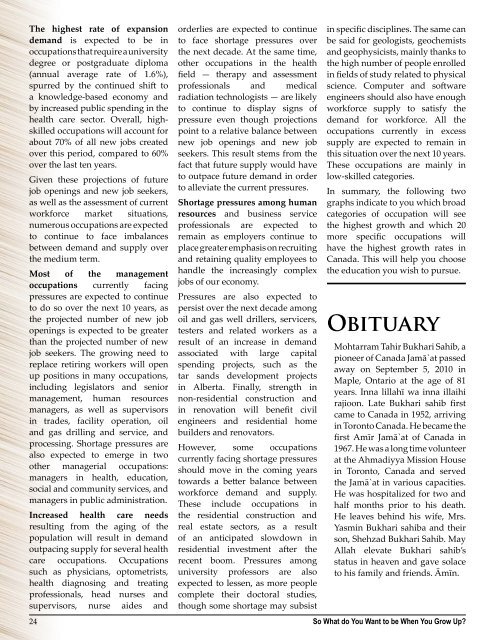English PDF - Ahmadiyya Gazette Canada
English PDF - Ahmadiyya Gazette Canada
English PDF - Ahmadiyya Gazette Canada
You also want an ePaper? Increase the reach of your titles
YUMPU automatically turns print PDFs into web optimized ePapers that Google loves.
The highest rate of expansion<br />
demand is expected to be in<br />
occupations that require a university<br />
degree or postgraduate diploma<br />
(annual average rate of 1.6%),<br />
spurred by the continued shift to<br />
a knowledge-based economy and<br />
by increased public spending in the<br />
health care sector. Overall, highskilled<br />
occupations will account for<br />
about 70% of all new jobs created<br />
over this period, compared to 60%<br />
over the last ten years.<br />
Given these projections of future<br />
job openings and new job seekers,<br />
as well as the assessment of current<br />
workforce market situations,<br />
numerous occupations are expected<br />
to continue to face imbalances<br />
between demand and supply over<br />
the medium term.<br />
Most of the management<br />
occupations currently facing<br />
pressures are expected to continue<br />
to do so over the next 10 years, as<br />
the projected number of new job<br />
openings is expected to be greater<br />
than the projected number of new<br />
job seekers. The growing need to<br />
replace retiring workers will open<br />
up positions in many occupations,<br />
including legislators and senior<br />
management, human resources<br />
managers, as well as supervisors<br />
in trades, facility operation, oil<br />
and gas drilling and service, and<br />
processing. Shortage pressures are<br />
also expected to emerge in two<br />
other managerial occupations:<br />
managers in health, education,<br />
social and community services, and<br />
managers in public administration.<br />
Increased health care needs<br />
resulting from the aging of the<br />
population will result in demand<br />
outpacing supply for several health<br />
care occupations. Occupations<br />
such as physicians, optometrists,<br />
health diagnosing and treating<br />
professionals, head nurses and<br />
supervisors, nurse aides and<br />
orderlies are expected to continue<br />
to face shortage pressures over<br />
the next decade. At the same time,<br />
other occupations in the health<br />
field — therapy and assessment<br />
professionals and medical<br />
radiation technologists — are likely<br />
to continue to display signs of<br />
pressure even though projections<br />
point to a relative balance between<br />
new job openings and new job<br />
seekers. This result stems from the<br />
fact that future supply would have<br />
to outpace future demand in order<br />
to alleviate the current pressures.<br />
Shortage pressures among human<br />
resources and business service<br />
professionals are expected to<br />
remain as employers continue to<br />
place greater emphasis on recruiting<br />
and retaining quality employees to<br />
handle the increasingly complex<br />
jobs of our economy.<br />
Pressures are also expected to<br />
persist over the next decade among<br />
oil and gas well drillers, servicers,<br />
testers and related workers as a<br />
result of an increase in demand<br />
associated with large capital<br />
spending projects, such as the<br />
tar sands development projects<br />
in Alberta. Finally, strength in<br />
non-residential construction and<br />
in renovation will benefit civil<br />
engineers and residential home<br />
builders and renovators.<br />
However, some occupations<br />
currently facing shortage pressures<br />
should move in the coming years<br />
towards a better balance between<br />
workforce demand and supply.<br />
These include occupations in<br />
the residential construction and<br />
real estate sectors, as a result<br />
of an anticipated slowdown in<br />
residential investment after the<br />
recent boom. Pressures among<br />
university professors are also<br />
expected to lessen, as more people<br />
complete their doctoral studies,<br />
though some shortage may subsist<br />
in specific disciplines. The same can<br />
be said for geologists, geochemists<br />
and geophysicists, mainly thanks to<br />
the high number of people enrolled<br />
in fields of study related to physical<br />
science. Computer and software<br />
engineers should also have enough<br />
workforce supply to satisfy the<br />
demand for workforce. All the<br />
occupations currently in excess<br />
supply are expected to remain in<br />
this situation over the next 10 years.<br />
These occupations are mainly in<br />
low-skilled categories.<br />
In summary, the following two<br />
graphs indicate to you which broad<br />
categories of occupation will see<br />
the highest growth and which 20<br />
more specific occupations will<br />
have the highest growth rates in<br />
<strong>Canada</strong>. This will help you choose<br />
the education you wish to pursue.<br />
Obituary<br />
Mohtarram Tahir Bukhari Sahib, a<br />
pioneer of <strong>Canada</strong> Jamā`at passed<br />
away on September 5, 2010 in<br />
Maple, Ontario at the age of 81<br />
years. Inna lillahī wa inna illaihi<br />
rajioon. Late Bukhari sahib first<br />
came to <strong>Canada</strong> in 1952, arriving<br />
in Toronto <strong>Canada</strong>. He became the<br />
first Amīr Jamā`at of <strong>Canada</strong> in<br />
1967. He was a long time volunteer<br />
at the <strong>Ahmadiyya</strong> Mission House<br />
in Toronto, <strong>Canada</strong> and served<br />
the Jamā`at in various capacities.<br />
He was hospitalized for two and<br />
half months prior to his death.<br />
He leaves behind his wife, Mrs.<br />
Yasmin Bukhari sahiba and their<br />
son, Shehzad Bukhari Sahib. May<br />
Allah elevate Bukhari sahib’s<br />
status in heaven and gave solace<br />
to his family and friends. Āmīn.<br />
24 So What do You Want to be When You Grow Up?
















